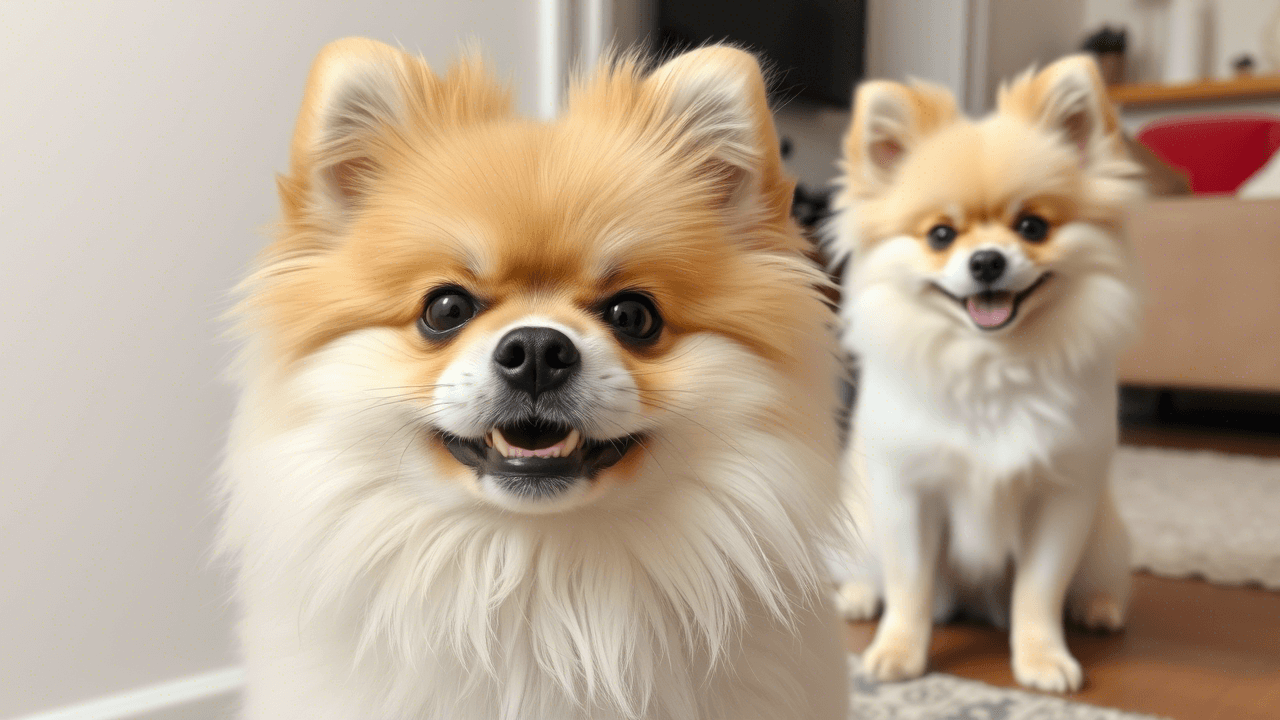The Pomeranian, often lovingly referred to as a “Pom,” is a small but bold member of the Spitz family. With their fox-like faces, thick double coats, and lively personalities, Pomeranians are a favorite among toy dog enthusiasts. Despite their petite size, these dogs have a big personality and a voice to match.
📸 Appearance
- Size: 3 to 7 pounds (1.4 to 3.2 kg)
- Height: 6 to 7 inches (15 to 18 cm)
- Coat: Thick double coat with a dense undercoat and a longer, fluffy outer coat
- Colors: Wide variety including orange, black, white, cream, blue, sable, chocolate, and more
- Ears: Small, erect, and triangular
- Tail: Plumed and arches over the back
- Face: Fox-like with expressive eyes and a pointed muzzle
🧠 Personality
- Lively and Curious: Always alert and eager to explore, Pomeranians have a zest for life.
- Intelligent: Quick learners, they can pick up commands and tricks rapidly.
- Bold and Confident: Often unaware of their tiny size, they can be quite fearless.
- Loyal: Form strong bonds with their owners and often become attached to one person.
- Social (with guidance): They enjoy company but can be wary of strangers and new pets without proper socialization.
📣 Bark Tendencies
Pomeranians are notoriously vocal. They make excellent watchdogs and will bark at noises, strangers, or even their own reflection.
Barking Triggers:
- Doorbells
- New people
- Other dogs
- Boredom or separation anxiety
Bark Control Tips:
- Train with “quiet” commands from a young age
- Provide adequate mental stimulation
- Avoid reinforcing barking by comforting them when they do it
- Use puzzle toys to keep them occupied
✅ Do’s and ❌ Don’ts
✅ Do’s:
- Brush Daily: Prevents matting and removes loose hair.
- Train Early: Set boundaries and teach basic commands while young.
- Socialize: Introduce to different people, pets, and environments.
- Provide Mental Stimulation: Toys, puzzles, and short games go a long way.
- Use a Harness: Their tracheas are delicate; avoid pulling on collars.
❌ Don’ts:
- Don’t Rough Play: They are small and fragile.
- Don’t Leave Alone for Too Long: They can develop separation anxiety.
- Don’t Skip Vet Visits: Regular checkups can catch common Pom health issues early.
- Don’t Overfeed: Pomeranians can gain weight quickly due to their small size.
❤️ Likes and Dislikes
Likes:
- Being the center of attention
- Learning new tricks and pleasing their humans
- Soft bedding and being cuddled (on their terms)
- Short walks and playtime
Dislikes:
- Being ignored or left alone
- Rough handling or loud environments
- Being overly dressed in uncomfortable outfits
- Getting wet—some Poms dislike baths or rain
🏥 Common Health Issues
- Dental Disease:
- Why it happens: Small dogs are prone to plaque buildup.
- Prevention: Brush teeth regularly, provide dental chews, and schedule professional cleanings.
- Luxating Patella (Slipping Kneecaps):
- What it is: The kneecap slips out of place, causing lameness or limping.
- Signs: Skipping gait, occasional hind-leg lameness
- Management: Weight control, joint supplements, in severe cases, surgery
- Collapsed Trachea:
- Caused by: Weak cartilage rings in the trachea
- Signs: Honking cough, difficulty breathing
- Prevention: Use harnesses instead of collars, avoid obesity
- Alopecia X (Black Skin Disease):
- Symptoms: Hair loss, especially in males; skin may darken
- Treatment: Variable – hormone therapy, neutering, or managing with grooming and skin care
🏢 Apartment Suitability
Pomeranians are excellent for apartment living:
Pros:
- Small and adaptable
- Doesn’t need a yard
- Enjoys being indoors
Cons:
- Vocal; thin walls can be an issue in shared buildings
- Needs daily mental stimulation or they may bark out of boredom
Tips:
- Use white noise machines to reduce barking triggers
- Ensure daily play and short walks
- Train early to prevent excessive noise
📝 Conclusion
The Pomeranian is a spirited, intelligent, and loving companion packed into a fluffy, pint-sized body. Perfect for experienced dog owners who can commit to training and grooming, Poms thrive in both small apartments and larger homes—as long as they get enough love and stimulation.
Frequently Asked Questions (FAQs)
Q: Are Pomeranians good with kids?
Q: How much grooming does a Pomeranian need?
Q: Do they shed a lot?
Q: Are Pomeranians easy to train?
Q: How long do Pomeranians live?

About SniffnTail
SniffnTail is your go-to destination for everything pets. From helpful advice, tips, and insights to thoughtfully selected products and resources, we’re here to support pet owners at every stage of their journey. Whether you're caring for a playful pup, a wise old cat, or anything in between, SniffnTail offers tools and knowledge to make pet parenting easier and more joyful.
Related Articles
 Dog Breeds • 23 min Read
Dog Breeds • 23 min ReadBeauceron Dog Breed Information: Temperament, Health, Training & Care Guide
Learn everything about the Beauceron dog breed from a board-certified veterinarian. This in-depth guide covers Beauceron temperament, health issues, training advice, nutrition, grooming, and more.
 Dog Breeds • 8 min Read
Dog Breeds • 8 min ReadGroodle Dog Breed Guide: Personality, Care, and Family Life
Explore the Groodle dog breed: temperament, training difficulty, grooming needs, and more. A complete guide for pet parents seeking a loving, family-friendly companion.
 Dog Breeds • 6 min read
Dog Breeds • 6 min readBanned Dog Breeds in Saudi Arabia: Pet Import Rules & Essential Guide
Moving to or living in Saudi Arabia with a dog? Learn which breeds are strictly banned, understand pet import rules, and get expert advice on choosing a legal, loving companion. Avoid legal issues – read this essential guide for pet parents!

